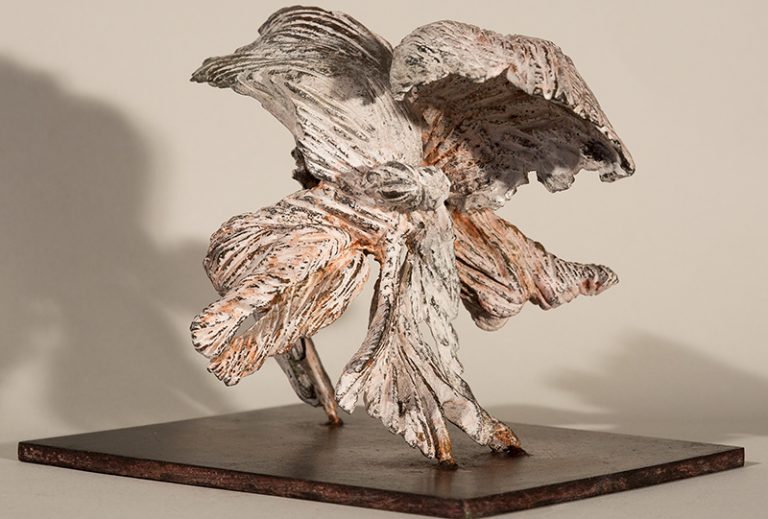In collaboration with various visual artists, a series of compositions is dedicated to angels. Konstantia Gourzi develops the compositional connection of various artistic forms of expression in this project.

The Project
“The connection between music, image and text has always been self-evident for me. Colour, form and sound are intrinsically linked, I cannot separate them. And I find composing with this connection constantly in mind to be both a challenge and a privilege.”
In this way, works have come about together with Norbert Banik, Christos Bouronikos, Yannis Gourzis, Jannis Kounellis, Vally Nomidou, Antje Tesche-Mentzen, Lila Polenaki, Alexander Polzin, Myrsini Vardopoulou, Athina Stamati and Nelly Tragousti. Gourzi has also written music for preexisting works of art, such as by Paul Klee.
At the beginning of 2015, Konstantia Gourzi began to work on the Angel Composition Series with different scoring combinations. Angels, which were depicted pictorially or in sculpture by artist friends, inspired her to portray them vividly in music. The music does not only interpret the sculpture / picture, but also gets close to it sonically, and the two works explore a new connection together. Most of the Angel pieces receive a newly-invented name, reflecting the sonic energy of the work.
Up to now originated compositions
Anájikon, the Angel in the Blue Garden for string quartet. The piece was composed for the Minguet String Quartet and premiered at the Kasseler Musiktage 2015. It was inspired by an angel sculpture by Alexander Polzin.
Paharión, the Red Angel in the Garden of las Huelgas, Dialogues between East and West for Schola Antiqua, Orthodox Psalmist, Ney, Clarinet / Bass Clarinet, Violin and Lyre. The piece was composed for Schola Antiqua, Madrid and the ensemble opus21musikplus. It was inspired by an angel sculpture by Alexander Polzin.
Astrolávos, the Angel at the Bottom of the Sea, Nine Constellations for Solo Oboe. The piece is commissioned by Francois Leleux and was premiered at the Ultraschall Festival 2016 in Berlin. The piece was created together with a digital painting by Jannis Gourzis.
Náraon, the Angel in the Yellow Garden, Seven Views of a Smile for Viola Solo. The piece was composed for Hariolf Schlichtig’s 65th birthday and is commissioned by his wife. It was inspired by an angel sculpture by Alexander Polzin.
Ny-él, Two Angels in the White Garden for orchestra in memoriam Claudio Abbado and Pierre Boulez. The piece was composed for the Lucerne Festival Academy Orchestra and is commissioned by the Lucerne Festival 2016. It was inspired by an angel sculpture by Alexander Polzin.
one touch for string quartet. The piece was composed for the Signum String Quartet and is mainly performed as part of the project quartweet of the Signum Quartet. It was inspired by an angel painting by Antje Tesche-Mentzen.
“Der Engel der Eewigkeit” – Hommage à Adolf Wölfli, for mixed choir. The piece is dedicated to Adolf Wölfli and his life as a painter, author and musician. It emerged in the confrontation with his paintings and his “inner” world, his pictorial themes, colors and their combinations.
Press reviews
„Als Höhepunkt kündigte sich ein neues Werk Gourzis an mit dem Titel ‚Ny-él, Two Angels in the White Garden’. (…) Bei der Uraufführung, die Gourzi selbst leitete, fielen archaische Rhythmen sowie sehnsuchtsvolle Bläsermelodien auf. Dazwischen schoben sich aber immer wieder störende Geräuschkulissen, bis das Orchester im letzten Satz einen eigentümlich schimmernden Klang erreichte.“ Basler Zeitung, 23 August 2016
„Ganz anders wiederum Konstantia Gourzi, die mit der Lucerne Festival Academy (LFA) konzertierte: Der Auftritt der gebürtigen Griechin, die in München lebt und lehrt, war programmatisch ein Höhepunkt. (…) Davon profitierten vor allem ‚Le Sacrifice’ von Iannis Xenakis und ‚Voyage into the Golden Screen’ von Per Nørgård, die Gourzi mit einer eigenen Uraufführung koppelte: ‚Ny-él – Two Angels in the White Garden’ op. 65. Das Werk ist Abbado und Boulez gewidmet. Orientalisch anmutende Melodien stoßen auf eruptives Schlagwerk.“ neue musikzeitung, 10/2016
